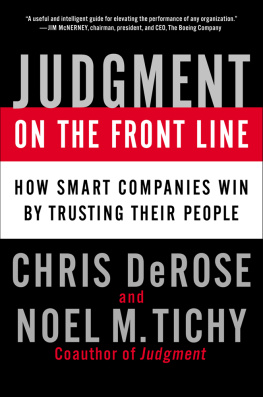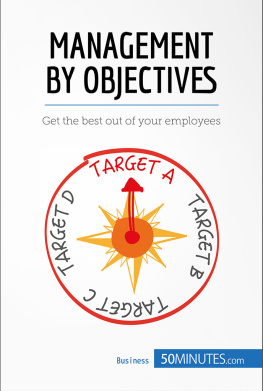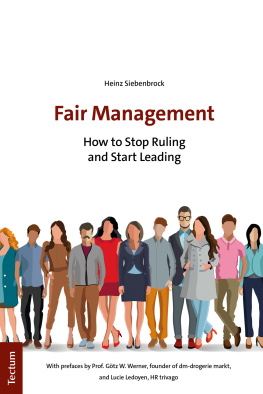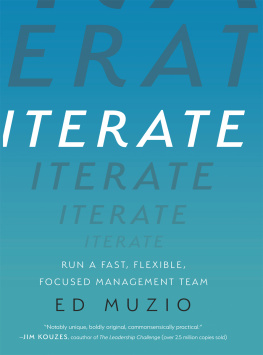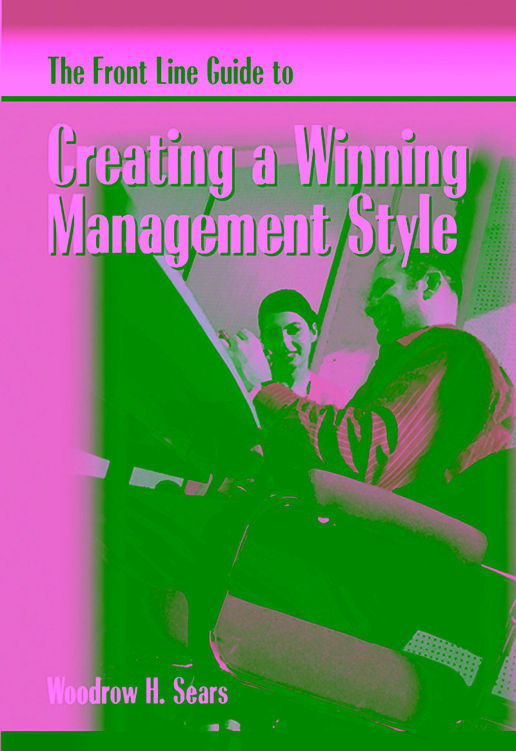The Front Line Guide t o CREATING A WINNIN G MANAGEMENT STYL E
Woodrow H. Sears
HRD Press, Inc. Amherst Massachusetts
Copyright 2007, HRD Press, Inc.
Published by:
HRD Press, Inc . 22 Amherst Roa d Amherst, MA 0100 800-822-2801 (U.S. and Canada ) 413-253-348 413-253-3490 (fax ) www.hrdpress.co m
All rights reserved. Printed in the United States of America. No part of this material may be reproduced or utilized in any form or by any means, electronic or mechanical, including photocopying, recording, or by any information storage and retrieval system, without written permission from the publisher.
ISBN 0-87425-937-1
Production services by Jean Miller Editorial services by Suzanne Bay Cover design by Eileen Klockars
DEDICATION
For Andrew Graves, MSgt. U.S.A.F. (Ret.): A master manager who energizes and involve s wherever he works.
Table of Contents
Preface .............................................................................. i x
Introduction ..................................................................... x i
Chapter 1: A Short History of the Search for Higher Productivity ................................................ 1 Management Style is Discovered............................ 2 A Matter of Beliefs ..................................................... 3
Chapter 2: Managers Make the Difference ..................
Chapter 3: Identifying Payoff Behaviors ......................
Chapter 4: Overcoming Worker Resistance ................. 1 Reinterpreting McGregor ........................................... 1 Another View of Theory X......................................... 1
Chapter 5: Developing Competence throug h Performance-Specific Feedback ................................... 2 Communication Skills: Prerequisites for a Winnin g Management Style ................................................... 2 Relationships Are Built on Shared Information ......... 2 Welcome to the World of Responsible Adults ........... 2 What about Power and Authority? ............................. 2 About Developing Competence.................................. 3 A View of Management Styles................................... 3 Giving Situation-Specific Feedback........................... 3
Chapter 6: Building Respect for Self, Team, an d Company ........................................................................ 3 In Times of Change ............................................... 4 Building Self-Respect and Self-Esteem ..................... 4 Building Respect within the Team ............................. 4 Building Respect for the Company ............................ 4
Chapter 7: Redefining Roles and Responsibilities ....... 5 All Tasks Must be Performed Satisfactorily............... 5 That Includes the Managers Role, Too ..................... 5
Chapter 8: Rewarding and Promoting .......................... 5 The Mysterious They and Them.......................... 6 Finding Advancement in a Flat Organization............. 6 The Manager as Mentor.............................................. 6
Chapter 9: As the Running Shoe People Say ........... 6 Just do it!..................................................................... 6 People with Winning Management Styles.................. 7
Chapter 10: Your Communication Style ...................... 7 Empathy and Communication Style : Being Accessible to Others...................................... 7 Critical Ability and Communication Style ................. 7 Searching and Communication Style ......................... 8 Advising Others.......................................................... 8 Mentoring ................................................................... 8 Summing It All Up ..................................................... 8
Chapter 11: Your Personal Style ................................... 8 Feelings and Personal Style........................................ 8 Thinking and Personal Style....................................... 9 Sensing and Personal Style......................................... 9 Intuition and Personal Style........................................ 9 One More Element of Personal Style ......................... 9
Chapter 12: Coming to Grips with Managemen t Style .............................................................................. 10 A Crazy Idea............................................................... 10 Its as Simple as You Want to Make It....................... 10 Other Paths to Theory Y............................................. 10
Chapter 13: Wrapping Up .............................................. 10 Finding a Safe Place to Try on New Behaviors.......... 10 A Few Words about Ethics......................................... 11 Now, Go Do It!........................................................... 11
References ........................................................................ 11
About the Author ............................................................. 11

Preface
This book was developed to achieve two purposes: First, I wanted to present the concept of management style as an identifiable, observable, and replicable set of attributes that are reflected in the behavior of managers as they deal with tasks and employees. An individuals management style reflects his or her personal beliefs and values; it is a blend of prescribed social behaviors that have been filtered or modi fied by what we know in our gut is the right thing to do. Regardless of the component values and behaviors of your management style, we can all make incremental improve ments that will help us be more effective with those we work with and, of no less importance, with our families.
My second purpose for writing this book is to relate this discussion of important managerial behaviors to research-based developmental programs such as the Managerial Assessment of Proficiency. Research involving thousands of managers in some of Americas leading professional, com mercial, industrial, and military organizations identified spe cific behaviors that can and do lead to managerial excel lencebehaviors that can be acquired by anyone reading this book. Developers of such managerial development programs validate their findings in a cross-section of corporate settings. The component competencies and values presented here have since become the de facto standard or starting point when an organization seeks to improve managerial performance.
The information in this book is not meant as a substitute for participation in a solid managerial assessment program, but it will reassure readers that creating a winning manage ment style is well within their capabilities. This book will show you how to do it.

Introduction
One of the things we know about human behavior is that it is generally predictable. When you itch, you scratchand the people who know you and watch your behavior can predict how you will scratch your itches. They know more about your behavior than you think.
Few people watch anyone as closely as workers watch their managers. They look for the cues and clues that allow them to figure out the managers mood. This is worker self-defense: Workers try to learn the best ways to approach their manager, and how and when to avoid him or her until certain moods pass. Its survival.



